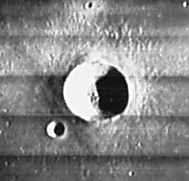Diophantus
Contents
Diophantus
|
Lat: 27.6°N, Long: 34.3°W, Diam: 17 km, Depth: 3.02 km, [/R%C3%BCkl%2019 Rükl: 19], [/Stratigraphy Eratosthenian] |
Table of Contents

LOIV-138-h3
Images
LPOD Photo Gallery Lunar Orbiter Images Apollo Images
- Apollo 15's southward looking Fairchild-camera frames AS15-M-2599, 2600, 2601, and 2602 show Diophantus during the local morning light. Diophantus is the pronounced crater in the foreground, near the upper margin. Research Danny Caes.
Maps
([/LAC%20zone LAC zone] 39B3) LAC map Geologic map LM map LTO map
Description
Description: Elger
([/IAU%20Directions IAU Directions]) DIOPHANTUS.--Forms with [/Delisle Delisle], its companion on the N., a noteworthy object. It is about 13 miles in diameter, with a wall, which has a distinct break in its continuity on the N., rising about 2,500 feet above the Mare. A rill-valley runs from the W. side of the ring towards the E. face of a triangular-shaped mountain on the W. of a line joining the formation with [/Delisle Delisle]. North are three bright little craters in a line, the middle one being much the largest. From the most westerly of these objects a light streak may be traced under a high sun, extending for many miles to another small crater on the N.E. of Diophantus, and expanding at a point due N. of the formation into a spindle-shaped marking. At sunrise, the E. portion of the streak has all the appearance of a cleft, with a branch about midway running to the S. side of [/Delisle Delisle]. Under the same phase a broad band of shadow extends from the N.W. wall to the triangular mountain just mentioned, representing a very sudden drop in the surface--resembling on a small scale the well-known [/Straight%20Wall "railroad"] W. of [/Thebit Thebit]. Diophantus has no central mountain.
Description: Wikipedia
Additional Information
- Depth data from [/Kurt%20Fisher%20crater%20depths Kurt Fisher database]
Pike, 1976: 3.02 km
Arthur, 1974: 2.97 km
Westfall, 2000: 3.02 km
Viscardy, 1985: 2.97 km
Cherrington, 1969: 2.59 km - Diophantus and A and B are thermal anomaly craters, implying youthful ages - [/Moore%20et%20al%2C%201980 Moore et al, 1980]
- Included in [/ALPO%20list%20of%20bright%20ray%20craters ALPO list of bright ray craters]
Nomenclature
Diophantus of Alexandria (b. between 200 and 214, d. between 284 and 298 AD), sometimes called "the father of algebra", was a Hellenistic mathematician.
LPOD Articles
Bibliography
A Portfolio of Lunar Drawings (Harold Hill), pages 72, 73.
This page has been edited 1 times. The last modification was made by - tychocrater tychocrater on Jun 13, 2009 3:24 pm - afx3u2